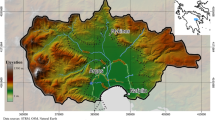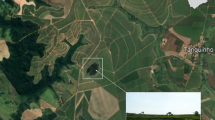Abstract
Recharge to an aquifer can be estimated by first calculating the effective rainfall using a soil moisture budgeting technique, and then by applying a recharge coefficient to indicate the proportion of this effective rainfall that contributes to groundwater recharge. In the Republic of Ireland, the recharge coefficient is determined mainly by the permeability and thickness of the superficial deposits (subsoils) that overlie the country’s aquifers. The properties of these subsoils also influence groundwater vulnerability, and a methodology has been developed for determining the recharge coefficient using the groundwater vulnerability classification. The results of four case studies have been used to develop a quantified link between subsoil permeability, aquifer vulnerability, recharge and runoff. Recharge and runoff coefficients are each classed into three groupings: high, intermediate and low. A high recharge coefficient equates to a low runoff coefficient, and vice versa. A GIS-based tool enables preliminary estimates of recharge to be made using these recharge coefficient groupings. Potential recharge is calculated as the product of effective rainfall and recharge coefficient. The actual recharge is then calculated taking account of the ability of the aquifer to accept the available recharge. The methodology could be applied to other temperate climate zones where the main aquifers have a substantial covering of superficial deposits.
Résumé
La recharge d’un aquifère peut être estimée en calculant dans un premier temps les précipitations efficaces via un bilan hydrique des sols puis en appliquant un coefficient de recharge prenant en compte la proportion de précipitations efficaces qui contribue à la recharge des eaux souterraines. Dans le cas de l’Irlande, ce coefficient de recharge est essentiellement déterminé par la perméabilité et l’épaisseur des formations superficielles qui recouvrent les aquifères. Les propriétés de ces formations influencent également la vulnérabilité des eaux souterraines et une méthodologie a été développée visant à déterminer le coefficient de recharge à partir des classes de vulnérabilité des eaux souterraines. Les résultats de quatre études de terrain ont contribué à définir un lien quantitatif entre perméabilité des dépôts superficiels, recharge et ruissellement. Les coefficients de ruissellement et de recharge sont classés en trois groupes: Fort, Intermédiaire et Faible. Un Fort coefficient de recharge correspond à un Faible coefficient de ruissellement et vice versa. L’utilisation d’outils de type SIG permet d’établir une première estimation de la recharge à partir de ces regroupements de coefficients de recharge. Le potentiel de recharge est le produit des précipitations efficaces par le coefficient de recharge. La recharge actuelle peut alors être calculée en prenant en compte la capacité d’emmagasinement de l’aquifère. Cette méthodologie pourrait être appliquée à d’autres zones climatiques tempérées caractérisées par d’importantes formations superficielles.
Resumen
La recarga de un acuífero puede estimarse calculando la lluvia efectiva a partir de técnicas de balance de agua en el suelo, y luego aplicando un coeficiente de recarga que indica la proporción de tal lluvia efectiva que contribuye a la recarga de las aguas subterráneas. En la República de Irlanda, los coeficientes de recarga se determinan principalmente teniendo en cuenta la permeabilidad y el espesor de los depósitos superficiales (subsuelos) que cubren los acuíferos regionales. Las propiedades de estos subsuelos también influencian la vulnerabilidad de las aguas subterráneas, y se ha desarrollado una metodología que para determinar el coeficiente de recarga usando la clasificación de vulnerabilidad de las aguas subterráneas. Los resultados de cuatro casos de estudio se han utilizado para desarrollar un vínculo cuantitativo entre la permeabilidad del subsuelo, la vulnerabilidad del acuífero, la recarga y el escurrimiento superficial. Los coeficientes de recarga y de escurrimiento superficial se clasifican en tres grupos: alto, intermedio y bajo. Un coeficiente de recarga alto se corresponde con un coeficiente de escurrimiento bajo, y viceversa. Una herramienta basada en SIG permite obtener estimaciones preliminares de la recarga usando tales grupos de coeficientes de recarga, La recarga potencial se calcula como el producto de la lluvia efectiva y el coeficiente de recarga. La recarga real se calcula teniendo en cuenta la capacidad del acuífero para aceptar la recarga disponible. La metodología podría ser aplicada a otras zonas de climas templados donde los acuíferos principales tienen una cubierta importante de sedimentos superficiales.
摘要:
含水层补给量概算首先要用土壤水量平衡法计算有效降雨量, 然后用入渗补给系数计算对地下水补给有贡献的有效降雨量。在爱尔兰共和国, 补给系数主要取决于渗透率和含水层上覆的表层沉积物的厚度。表土性状也影响着地下水的脆弱性。利用地下水脆弱性分级方法建立了一种确定补给系数的方法。在四个实例地区, 确定了表土渗透率、含水层脆弱性、补给量和径流量的定量联系。补给系数和径流系数各分为高、中、低三级。补给系数高等同于径流系数低, 反之亦然。利用补给系数分级, 采用GIS手段可以初步估计补给量。潜在补给量等于有效降雨量和补给系数的乘积。然后考虑含水层接受有效补给的能力来计算实际补给量。该方法适用于含水层为表层沉积物覆盖的气候温暖地区。
Resumo
A recarga de um aquífero pode ser inicialmente estimada através do cálculo da precipitação efectiva, usando a técnica do balanço de água no solo, e aplicando em seguida um coeficiente de recarga que indica a proporção da precipitação efectiva que contribui para a recarga subterrânea. Na República da Irlanda, o coeficiente de recarga é definido principalmente a partir da permeabilidade e espessura dos depósitos superficiais (subsolos) que cobrem os aquíferos nacionais. As propriedades destes subsolos também influenciam a vulnerabilidade dos aquíferos, pelo que se desenvolveu uma metodologia para a determinação do coeficiente de recarga a partir da classificação da vulnerabilidade dos aquíferos. Os resultados de quatro casos de estudo foram usados para quantificar a interdependência entre permeabilidade do subsolo, vulnerabilidade dos aquíferos, recarga e escoamento superficial. Tanto o coeficiente de recarga como o coeficiente de escoamento superficial são classificados em três grupos: Elevado, Intermédio e Baixo. Um coeficiente de recarga Elevado equivale a um coeficiente de escoamento superficial Baixo e vice versa. Utilizando ferramentas SIG é possível obter estimativas preliminares da recarga a partir destes grupos de coeficientes de recarga. A recarga potencial é calculada multiplicando a precipitação efectiva pelo coeficiente de recarga. A recarga real é posteriormente calculada a partir da capacidade do aquífero para receber a recarga disponível. Esta metodologia poderá ser aplicada a outras regiões de clima temperado onde os depósitos superficiais constituam uma cobertura importante dos aquíferos.






Similar content being viewed by others
References
Allen RG, Pereira LS, Raes D, Smith M (1998) Crop evapotranspiration: guidelines for computing crop water requirements. Food and Agriculture Organisation Irrigation and Drainage Paper 56, FAO, Rome, Italy
Aller LT, Bennett T, Lehr JH, Petty RJ, Hackett G (1987) DRASTIC: a standardized system for evaluating ground water pollution potential using hydrogeologic settings. EPA/600/2-87/035, US Environmental Protection Agency, Washington, DC
Aslibekian O (1999) Regional assessment of groundwater recharge. GSI Groundw Newslett 35:8–11
British Standards Institution (1999) BS 5930:1999, Code of practice for site investigations. British Standards Institution, London
Brogan J, Crowe M, Carty G (2002) Towards setting environmental quality objectives for soil: developing a soil protection strategy for Ireland: a discussion document. Environmental Protection Agency, Wexford, Ireland
Daly D (2004) Groundwater at risk: putting geoscientific information and maps at the core of land use and environmental decision-making. John Jackson Lecture 2004, Occasional Papers in Irish Science and Technology 28, National Board for Science and Technology, Dublin, 32 pp
Daly D, Misstear BDR (2001) The groundwater protection scheme in Ireland: a risk-based tool for effective land-use planning. In: Protecting groundwater, applying policies and decision making tools to land-use planning. Conference Proceedings, Birmingham, National Groundwater and Contaminated Land Centre Project NC/00/10, Environment Agency, Solihul, UK
Daly D, Warren W (1998) Mapping groundwater vulnerability: the Irish perspective. In: Robins NS (ed) Groundwater pollution, aquifer recharge and vulnerability, Geological Society, London, Spec. Publ. 130, pp 179–190
Daly EP (1994) Groundwater resources of the Nore River basin. Report 94/1, Geological Survey of Ireland, Dublin
Department of Environment and Local Government (DoELG) (1999) Groundwater protection schemes. Department of Environment and Local Government, Environmental Protection Agency and Geological Survey of Ireland, Dublin
Fitzsimons VP, Misstear BDR (2006) Estimating groundwater recharge through tills: a sensitivity analysis of soil moisture budgets and till properties in Ireland. Hydrogeol J 14:548–561
Fitzsimons VP, Daly D, Deakin J (2003) GSI guidelines for assessment and mapping of groundwater vulnerability to contamination, draft. Geological Survey of Ireland, Dublin
Geological Survey of Ireland (2008) Groundwater vulnerability maps. Groundwater web-mapping site http://www.gsi.ie/Mapping. Cited 16 June 2008
Lerner DN, Issar AS, Simmers I (1990) Groundwater recharge: a guide to understanding and estimating natural recharge. International Contributions to Hydrogeology 8. Heise, Germany
MacCarthaigh M (1994) Summary details of water balances in Glyde, Dee, Finn and Blackwater (Monaghan) catchments for the period December 1975–November 1977. Environmental Protection Agency, Dublin
Meehan R, Bulfin M, Cronin C, Fealy R, Green S, Loftus M, Radford T (2003) Soil and subsoil mapping as part of the EU Water Framework Directive–baseline environmental mapping for Ireland. In: Irish Quaternary Association (IQUA), Spring Meeting, Abstracts, IQUA, Dublin
Misstear BDR (2000) Groundwater recharge assessment: a key component of river basin management. In: River basin management, Proceedings, National Hydrology Seminar, Tullamore, 2000, pp 52–59
Misstear BDR, Brown L (2008) Water Framework Directive: Recharge and groundwater vulnerability. STRIVE Report Series No. 6, Environmental Protection Agency, Wexford, Ireland
Misstear BDR, Daly D (2000) Groundwater protection in a Celtic region: the Irish example. In: Robins NS, Misstear BDR (eds) Groundwater in the Celtic regions: studies in hard rock and Quaternary hydrogeology, Geological Society, London, Spec. Publ. 182, pp 53–65
Misstear BDR, Fitzsimons V (2007) Estimating groundwater recharge in fractured bedrock aquifers in Ireland. Chapter 16. In: Krasny J, Sharp J (eds) Groundwater in Fractured Rocks, International Association of Hydrogeologists, Spec. Publ. 9, IAH, Goring, UK, pp 243–257
Misstear BDR, Banks D, Clark L (2006) Water wells and boreholes. Wiley, Chichester, UK
Misstear BDR, Brown L, Hunter Williams N (2008) Groundwater recharge to a fractured limestone aquifer overlain by glacial till. Q J Eng Geol & Hydrogeol (in press)
Moe H, Daly D, Hunter-Williams T, Mills P, Gaston L (2007) A national assessment of groundwater abstraction pressures. In: Proc. 27th annual groundwater seminar on Groundwater Pressures and Opportunities, International Association of Hydrogeologists (Irish Group), Tullamore, 24–25 April 2007, pp 5–32
O’Shea G, Lee M (2007) Geological Survey of Ireland’s groundwater web-mapping site. GSI Groundw Newslett 46:2–3
Ó Súilleabháin C (2000) Assessing the boundary between high and moderate permeability subsoils. MSc Thesis, Trinity College, Dublin, Ireland
Rushton KR (2005) Estimating recharge for British aquifers. J Chart Inst Water Environ Manage 19:115–124
Rushton KR, Kawecki MW, Brassington FC (1988) Groundwater model of conditions in the Liverpool Sandstone Aquifer. J Chart Inst Water Environ Manage 2:67–84
Scanlon BR (1985) A groundwater study of the Maine River basin, County Kerry. Report series SR 85/1, Geological Survey of Ireland, Dublin, 35 pp
Scanlon BR, Healy RW, Cook PG (2002) Choosing appropriate techniques for quantifying groundwater. Hydrogeol J 10:18–39
Swartz M, Misstear BDR, Daly D, Farrell ER (2003) Assessing subsoil permeability for groundwater vulnerability. Q J Eng Geol Hydrogeol 36(part 2):173–184
Working Group on Groundwater (2005) Water Framework Directive (WFD) Pressures and impacts assessment methodology: guidance on the assessment of the impact of groundwater abstractions. Geological Survey of Ireland, Environmental Protection Agency and River Basin Districts Coordinating Authorities, Dublin
Working Group on Groundwater (2008) National recharge map of Ireland. Geological Survey of Ireland, Environmental Protection Agency and River Basin Districts Coordinating Authorities, Dublin
Wright GR, Aldwell CR, Daly D, Daly EP (1982) Groundwater resources in the Republic of Ireland, vol 6. In: European community’s atlas of groundwater resources, SDG, Hannover, Germany
Acknowledgements
The work described in this paper is based on a project which was carried out for the Environmental Protection Agency under the ERTDI Programme 2000–2006. The project title was “2002-W-MS/16: Recharge and Groundwater Vulnerability”. The authors would like to thank the members of the project steering group: M. Keegan and A. Wemaere (Environmental Protection Agency), P. Johnston (Trinity College Dublin), S. Fletcher (Environment Agency of England and Wales), V. Fitzsimons (Scottish Environmental Protection Agency), P. McConvey (Environment and Heritage Service, Northern Ireland) and R. Meehan. Figure 6 was prepared by H. Moe (CDM Ireland Ltd), P. Mills (Compass Informatics) and M. Craig (Environmental Protection Agency). B. Misstear would like to acknowledge the support of B. Miller, I. Acworth and their colleagues at the Water Research Laboratory, University of New South Wales, during a sabbatical in late 2007, when this paper was written.
Author information
Authors and Affiliations
Corresponding author
Rights and permissions
About this article
Cite this article
Misstear, B.D.R., Brown, L. & Daly, D. A methodology for making initial estimates of groundwater recharge from groundwater vulnerability mapping. Hydrogeol J 17, 275–285 (2009). https://doi.org/10.1007/s10040-008-0342-x
Received:
Accepted:
Published:
Issue Date:
DOI: https://doi.org/10.1007/s10040-008-0342-x




